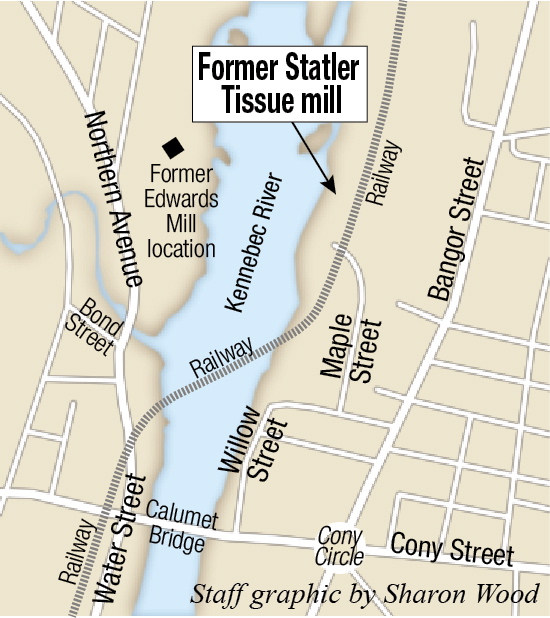AUGUSTA — With rail advocates saying Augusta is well-positioned to eventually bring passenger train service back to the city, city councilors say they plan to approve a proposal to look into it.
Richard Rudolph, a director of the nonprofit rail advocacy organization Maine Rail Group, told city councilors Thursday that trains bringing passengers to and from Augusta could bring money and development to the city. That’s especially true of the area surrounding the city-owned former Statler mill on the city’s east side, which Rudolph suggested could be the station at the end of the line and a regional transportation hub.
Randolph told councilors that wherever rail lines go in, transit-oriented development follows.
“So I suspect if in fact train service went over the bridge to east Augusta, onto the property the city owns, that would be a huge economic generator. And I think there is enough land over there you could certainly have a railroad station along with whatever else would be put in.”
Councilor Cecil Munson said the council will sponsor a resolution to look into passenger rail service for Augusta, and City Manager William Bridgeo said it will be ready for councilors to vote on Thursday.
“I certainly support the idea of bringing rail service to our capital city here in Maine,” said Ward 2 Councilor Darek Grant. “I realize this is just kind of the first step.”
Grant asked if approving the resolution would prevent the city from considering other redevelopment proposals not involving rail for the former Statler property. Bridgeo said it would not.
The resolution would not obligate the city to take action, or even apply for grant funding. But it would provide an official show of support for the return of passenger rail to the city, which is something Rudolph said is needed for the process to move forward.
The council resolution suggests a federal Transportation Investment Generating Economic Recovery grant should be sought to fund detailed planning, and other grant opportunities should be sought as well. Rudolph said grant money could be used to study the proposaland answer questions likely to be asked by officials before the city decides to move forward with it.
Rudolph said he believes the proposed project has a good chance of winning funding in part because it is multi-modal, meaning it would involve several forms and uses of transportation serving the region. It would also operate from one location, the city-owned former Statler property, which city officials have renamed Kennebec Lockes and hope to see privately redeveloped. The property was acquired through non-payment of taxes and cleared of most mill buildings in 2009.
A consultant hired to suggest potential ways the Kennebec Lockes site could be redeveloped said it could be a mixed use commercial, residential and retail site, with a passenger train station included. Rudolph said federal officials are interested in supporting multi-model projects.
“I think the city of Augusta really is in a great position to move forward with this, because it’s a really multi-modal project,” Rudolph said. “If it is somehow linked to the Downeaster, then it is an inter-city project. But there’s a number of people that travel from Augusta to Portland every day, or vice versa, and so it’s also a commuter project. Then if you think in terms of people coming down from Waterville or Bangor, or maybe from the Belfast area, if there is some sort of shuttle bus service connected to it, then it’s a grand multi-modal project and that’s the kind of thing the (Federal Railroad Administration) really favors.”
Rudolph the proposal would also need the support of state transportation officials and Maine’s legislative delegation.
Rudolph said the city could have a small train stop downtown, and the former Statler site could be home to a larger train station serving the region, which would mean trains would run through downtown and cross the river on the trestle.
The resolution specifically notes that any plan to restore rail service to the city that would involve bringing trains through downtown would have to include plans and funding to replace the approximately 200 “temporary” parking spaces built on top of the state-owned rail space that runs along Commercial and Water streets.
Bridgeo said the agreement between the city and state Department of Transportation that allowed the city to fill in the rail bed to increase parking downtown specifies the city would have to remove the gravel from the rails within 30 days at state officials’ request.
So Bridgeo said a plan to bring passenger trains back to Augusta must also include plans to replace those 200 parking spaces, potentially by adding one or two decks to the public parking garage on Dickman Street, just above Commercial Street, which Bridgeo said was designed to be able to take on more parking.
“I was here when the parking facility was designed and bid out and it was specifically done to accommodate two more decks,” Bridgeo said. “The substructure is of sufficient heft to carry two more decks.”
The approximately 34 miles of inactive track between Augusta and Brunswick is owned by the state. Amtrak’s Downeaster line to Boston ends in Brunswick since the run, which previously stopped in Portland, was extended north in 2012.
Rudolph said when passenger rail came to Brunswick a new hotel and other buildings were put in near the train station. He said the station probably generated $50 million to $60 million in economic development in Brunswick.
However, it has also generated complaints from some Brunswick residents who have complained about a proposal to build a train layover building there, where trains would be kept overnight, out of concern noise from idling trains could bother them.
Maine Rail Group officials, in a previous discussion with councilors, said the former Statler site, some parts of which are not near any residences, could possibly take the place of the proposed Brunswick train layover building.
Keith Edwards — 621-5647
kedwards@centralmaine.com
Twitter: @kedwardskj
Send questions/comments to the editors.



